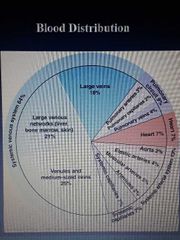![]()
![]()
![]()
Use LEFT and RIGHT arrow keys to navigate between flashcards;
Use UP and DOWN arrow keys to flip the card;
H to show hint;
A reads text to speech;
12 Cards in this Set
- Front
- Back
|
Blood flow through a vessel depends on two things |
Pressure difference between the two ends and vascular resistance (impediment of blood flow through the vessel) |
|
|
Blood flows from areas of __ pressure to ___ pressure |
High to low |
|
|
Arterial walls are thicker and stronger than veins, veins have thinner walls that are ___ times more distensible (can dialate) |
6 to 10 times |
|
|
Arterioles control pressures and ___ during exercise |
Dialate during exercise to pump more blood |
|
|
The body contains more ___ compared to other parts of the vascular system |

Veins |
|
|
___ pushes blood up the veins in the legs |
Muscle contraction |
|
|
The pulsitile nature of the cardiac cycle causes pressure variation (systole and diastole) or blood pressure |
120 systole / 80 diastole is normal |
|
|
The left side of the heart pressure is higher and the right side pressure is lower to help with |
Venous return |
|
|
Which form of energy provides fundamental pressure within the cardiovascular system |
Potential energy=pressure energy |
|
|
Pressure does not affect velocity |
The decrease on the area in a vessel doesn't increase the speed of the blood |
|
|
Kinetic energy is the energy of motion (velocity) and can increase with |
Exercise and stenosis |
|
|
Distal to stenosis |
Velocity decreases |

